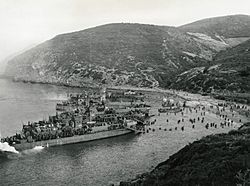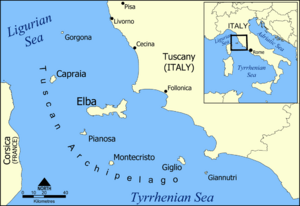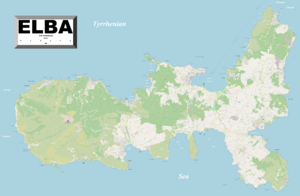Invasion of Elba facts for kids
Quick facts for kids Invasion of Elba |
|||||||
|---|---|---|---|---|---|---|---|
| Part of the Italian Campaign of World War II | |||||||
 French troops landing on Elba, 17 June 1944 |
|||||||
|
|||||||
| Belligerents | |||||||
| Commanders and leaders | |||||||
| Units involved | |||||||
|
2 infantry battalions | ||||||
| Casualties and losses | |||||||
|
|
||||||
The invasion of Elba, also known as Operation Brassard, was an important part of the Italian campaign during World War II. This attack happened between June 17 and 19, 1944. Free French Forces led the invasion, with help from British and American ships and planes.
German soldiers captured later said that the Allied forces had been seen near Corsica. This meant the German defenders on Elba knew an invasion was coming about 24 hours beforehand. They fought for two days before being allowed to retreat to the Italian mainland.
Contents
About the Invasion of Elba
Why Elba Was Important
The Island of Elba is about 10 kilometers (6 miles) from the Italian mainland. It's across from the town of Piombino in Tuscany. Elba is the third largest Italian island, after Sicily and Sardinia. It's also the biggest island in the Tuscan Archipelago.
The island is about 30 kilometers (19 miles) long. It's wider at its ends (18 km or 11 miles) and narrower in the middle (4 km or 2.5 miles). Elba is a dry and mountainous island. Monte Capanne, at 1,019 meters (3,343 feet), is its highest point. The coast has steep cliffs and deep, curved bays. In 1939, about 30,000 people lived on Elba. Most lived in Portoferraio, the main harbor, or Marciana on the north shore.
Italy's Surrender
On September 8, 1943, Italy announced it was surrendering to the Allies. This was called the armistice. At that time, Italian forces were defending the Tuscan coast near Elba. The 215th Coastal Division was in charge of defending the coast and the Tuscan islands. On Elba, about 8,300 Italian soldiers and sailors were stationed. There were also about 50 German soldiers, mostly operating radar.
After the Allies invaded Sicily and mainland Italy, the Germans decided to move their troops out of Sardinia and Corsica. They didn't want their soldiers to get trapped by the Allies. Controlling Elba was important for these evacuations.
On September 9, the Italian commander on Elba, General Achilles Gilardi, was told to fight against any German actions. The Italian Navy also ordered its ships to leave ports to avoid being captured by the Germans. Many ships headed for Portoferraio.
The Germans started taking over ships in Piombino. An Italian coastal battery fired on them, forcing the Germans to release the men and return the ships. The next day, Italian ships fought against German boats near Portoferraio. Later, reports came that many German ships were gathering in Piombino.
German Takeover of Elba
On September 11, General Gilardi was ordered to talk with German commanders, but he refused. German planes dropped leaflets over Elba, telling Gilardi to surrender or face heavy bombing. They warned that soldiers who kept fighting would be treated as terrorists and shot.
The Italian Navy ordered all its ships to sail to Palermo in Sicily. Those ships in Portoferraio that could sail, left. The Germans took over Piombino on the mainland. Over the next few nights, German boats tried to approach Elba, but Italian coastal guns fired on them.
On September 15, German officers landed on Elba and again demanded Gilardi's surrender, but he refused. The Germans also tried to land on Palmaiola islet but were pushed back. On September 16, German bombers attacked Portoferraio. This caused about 100 deaths and 150 injuries, overwhelming the island's medical help. Gilardi tried to negotiate, but a German invasion force was already on its way.
Operation Golden Pheasant
On September 17, 1943, German Junkers Ju 52 planes dropped about 600 paratroopers near Portoferraio. At the same time, German infantry arrived by ferry from Livorno and landed at Portoferraio. The Italian forces on Elba did not resist. The Germans quickly captured the garrison and took over the artillery batteries.
The Germans then pressured the Italian prisoners to sign papers agreeing to stay in military service or be sent to prison camps in Germany. General Gilardi delayed, and only two of his officers agreed to stay in the army. The Germans then arrested Gilardi and about 300 other Italian officers. They were sent to prison camps in occupied Poland.
German Defenses on Elba
By May 1944, the German commander, General Franz Gall, was in charge of Elba's defenses. His forces included two German fortress battalions and one Italian coastal defense battalion. Many of the German soldiers had suffered from frostbite on the Eastern Front. The Italian battalion had about 650 men, many of whom had been forced to "volunteer."
The German navy also had a unit of 350 naval gunners and 200 Italian coastal gunners. They operated six Italian coastal batteries. These batteries defended the north and east shores of Elba. Another German artillery unit with Italian howitzers and guns was also on the island.
The most modern weapons were German 88 mm guns and 20 mm guns. These were placed on hills across the bay from Portoferraio. The island's defense was divided into 13 coastal sectors. Local fishermen told the Allies that minefields protected the entrances to several bays. By June 1944, about 2,600 German and Italian soldiers defended Elba. Many of their weapons were Italian, and some German officers were older reservists.
Planning the Invasion
Allied Strategy

The Allied 15th Army Group captured Rome on June 4, 1944. This forced the German armies to retreat north. However, many Allied troops were then moved from Italy to prepare for the invasion of southern France, called Operation Dragoon. This reduced the number of Allied divisions in Italy.
Elba was very important because it lay between the mainland and Corsica. It blocked access to the Tyrrhenian Sea. Before Rome was captured, Elba was a useful German outpost that protected supply ships. Planning for the invasion of Elba, called Operation Brassard, began in April 1944.
Adolf Hitler believed it was very important to hold Elba for as long as possible. On June 12, the German commander in Italy was told that "Elba must be defended to the last man and the last cartridge." German reinforcements started arriving on Elba on June 14. The Allies didn't know about these reinforcements and thought the naval activity was an evacuation.
Operation Brassard Forces
Force 255 (Ground Troops)
The main ground force for Elba's capture was called Force 255. It included three French Regimental Combat Teams. These teams were made up of West African and Moroccan troops serving with the French. Two commando units, the Bataillon de Choc and the Commandos d’Afrique, were tasked with silencing the shore batteries. They would land secretly before the main invasion.
The invasion force included 11,667 troops, 86 guns, 250 mules, and 481 vehicles. General Joseph Magnan was in command of this force. General Jean de Lattre de Tassigny was the overall commander of the operation.
The naval part of the operation, Force N, was led by Rear-Admiral Thomas Troubridge. The Royal Navy (British) and US Navy provided many landing ships and craft. These included large landing ships (LSTs), tank landing craft (LCTs), and infantry landing craft (LCIs).
The British also provided gunboats, rocket landing craft, and other support vessels. Twelve motor torpedo boats and 39 PT boats were used for diversions and close support. Air support was provided by American fighter and bomber groups.
The Invasion Plan
Force N was divided into three groups:
- Motor Torpedo Boats and PT boats: These boats would create diversions and land French Commandos on the northern side of the island. Their goal was to attack the German gun batteries there.
- Landing Craft Infantry (LCI) and Motor Launches: These would target four beaches on the south coast.
- Main Force: This group included more LCIs, LSTs, and other landing craft. The main landings were planned for two beaches, codenamed Kodak Amber and Kodak Green, at 4:00 a.m. Heavier equipment would follow later.
Admiral Troubridge expected that the German shore batteries would be destroyed by air attacks and the commandos. He also believed the German garrison was small and wouldn't resist much.
The Invasion Begins
On June 16, the day before the invasion, German planes spotted two groups of invasion ships. However, they thought these were just normal supply convoys. To keep the attack a surprise, there was no bombing before the invasion until the night of June 16/17. Then, 26 British Vickers Wellington planes bombed Portoferraio and Porto Longone.
The invasion fleet, with 270 ships, arrived off Elba just after midnight on June 17. The first group of ships dropped off 87 French Commandos in rubber boats near Cape Enfola. The naval group then started creating a smoke screen. Other boats created more smoke and fired rockets to make it look like troops were landing near Portoferraio.
In the south, the main invasion force approached the island. At 3:38 a.m., the Germans fired a signal flare and began shooting at the landing craft. British Royal Navy Commandos landed at 3:50 a.m. Their goal was to capture or destroy the German anti-aircraft ship Köln, which was docked at Marina di Campo. This ship had a clear view of the landing beaches.
The Commandos quickly captured Köln and secured the nearby jetty. However, the French division landing craft faced heavy machine gun and 88 mm gun fire. By 7:00 a.m., German defenses forced some landing craft to retreat. Many landing craft had to divert to Kodak Green beach, causing delays and crowding. Some landing craft couldn't land until 2:00 p.m.
The Commandos, unaware of the beach diversion, had to wait for hours for the French troops to clear the village. During this time, the Commandos suffered many losses. They were under constant artillery and small arms fire. Explosions on the jetty killed almost all the Commandos and their prisoners. The Köln also caught fire and its ammunition exploded.
Within two hours of landing, French commandos reached the top of the 1,300-foot Monte Tambone Ridge, which overlooked the landing areas. Portoferraio was captured by the 9th Division on June 18. Most of the island was secured by the next day. Fighting in the hills between the Germans and the French colonial infantry was fierce. The French used flamethrowers to clear out German positions. On June 19, the German commander asked for permission to evacuate his remaining forces. By the evening of June 20, about 400 German soldiers had been evacuated to the mainland.
After the Invasion
Casualties
After the fighting, the Germans lost about 500 soldiers killed, and 1,995 were taken prisoner. The French lost 252 soldiers killed or missing, and 635 were wounded. The British lost 38 killed and nine wounded.
Later reports said that the French had 201 killed, 51 missing, and 635 wounded. The British had 38 killed and nine wounded, with the Royal Navy losing 65 killed and 100 wounded. The German and Italian defenders had 672 killed or missing (507 German and 165 Italian). Also, 1,383 German and 612 Italian troops were taken prisoner. A French report also listed the capture of 48 guns and 100 machine guns.
Images for kids
-
Map of the Tuscan Archipelago







